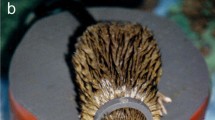Summary
Hypopygus fires its electric organ in short pulses of less than 1 msec duration, at a variable rate between 60 and 100 Hz. While resting, the animal hovers near electrically detectable objects and follows their motions. This “electromotor” response is exploited to measure performance in electrolocation as a function of object size (Figs. 1, 2).Hypopygus pays particular attention to sensory feedback associated with its own discharges. It briefly raises its rate of discharge in response to sudden changes in feedback. Such changes, for example, are caused by extrinsic pulses which briefly precede or coincide with its own discharges (Figs. 3–5). In addition, electrolocation deteriorates when extrinsic pulses of sufficient intensity continually interfere with its own discharges in this manner, whereas non interfering pulses of comparable intensity have no adverse effect (Fig. 6). By modulating its frequency of discharge the animal avoids long sequences of coincidences between its discharges and trains of extrinsic pulses (Figs. 7,9). By only “listening” to sensations associated with its own discharges,Hypopygus appears to be able to electrolocate in the near presence of conspecifics. It remains unknown how the animal distinguishes feedback from its own discharges against sensations caused by extrinsic pulses.
Similar content being viewed by others
References
Belbenoit, P.: Conditionnement instrumental de l'électroperception chezGnathonemus petersii. Z. vergl. Physiol.67, 192–204 (1969)
Belbenoit, P.: Détermination de la distance maximale d'électroperception des objects chez les Mormyridés. J. Physiol. (Paris)62, Suppl. 3, 344 (1970)
Bennett, M. V. L.: Electric organs. In: Fish physiology, vol. 5, eds. Hoar and Randall, p. 347–491. New York: Academic Press 1971a
Bennett, M. V. L.: Electroreception. In: Fish physiology, vol. 5, eds. Hoar and Randall, p. 493–574. New York: Academic Press 1971b
Bennett, M. V. L., Steinbach, A. B.: Influences of electric organ control system on electrosensory afferent pathways in Mormyrids. In: Neurobiology of cerebellar evolution and development, ed. R. Llinas. Chicago: American Medical Assoc. 1969
Bullock, Th. H.: Biological sensors. In: Vistas in science. Univ. of New Mexico Press 1968
Bullock, Th. H.: Species differences in effect of electroreceptor input on electric organ pacemakers and other aspects of behavior in electric fish. Brain Behav. Evol.2, 85–118 (1969)
Bullock, Th. H., Hamstra, R. H., Scheich, H.: The jamming avoidance response of high frequency electric fish. J. comp. Physiol.77, 1–48 (1972)
Hagiwara, S., Kusano, K., Negishi, K.: Physiological properties of electroreceptors of some gymnotids. J. Neurophysiol.25, 430–449 (1962)
Hagiwara, S., Morita, H.: Coding mechanisms of electroreceptor fibers in some electric fish. J. Neurophysiol.26, 551–567 (1963)
Harder, W.: Nachweis aktiver elektrischer Ortung bei Mormyriden. Z. Tierpsychol.30, 94–102 (1972)
Heiligenberg, W.: Electromotor response in the electric fish,Eigenmannia. Nature (Lond.)243, 301–302 (1973a)
Heiligenberg, W.: Electrolocation of objects in the electric fish,Eigenmannia (Rhamphichthyidae, Gymnotoidei). J. comp. Physiol.87, 137–164 (1973b)
Hopkins, C. D.: Patterns of electrical communication among gymnotid fish. PhD Thesis, Rockefeller University, N. Y. (1972)
Hopkins, C. D.: Electrical communication in fish. American Scientist (in press, 1974)
Larimer, J. L., MacDonald, J. A.: Sensory feedback from electroreceptors to electromotor pacemaker centers in gymnotids. Amer. J. Physiol.214, 1253–1261 (1968)
Lissmann, H. W.: Ecological Studies on Gymnotids. In: Bioelectrogenesis, eds. C. Chagas and A. Paes de Carvalho. Amsterdam-London-New York-Princeton: Elsevier Publishing Co. 1961
Lissmann, H. W., Machin, K. E.: The mechanism of object location inGymnarchus niloticus and similar fish. J. exp. Biol.35, 451–486 (1958)
MacDonald, J. A., Larimer, J. L.: Phase-sensitivity ofGymnotus carapo to low-amplitude electrical stimuli. Z. vergl. Physiol.70, 322–334 (1970)
Scheich, H., Bullock, Th. H.: The role of electroreceptors in the animal's life. II. The detection of electric fields from electric organs. In: Handbook of sensory physiology, vol. 3 (ed. Fessard). Berlin-Heidelberg-New York: Springer (1974)
Watanabe, A., Takeda, K.: The change of discharge frequency by A.C. stimulus in a weak electric fish. J. exp. Biol.40, 57–66 (1963)
Author information
Authors and Affiliations
Additional information
This research was supported by an Alfred P. Sloan Foundation grant for research and training, a travel grand by the Deutsche Forschungsgemeinschaft and grants from the NSF, NHI and ONR. I thank Prof. Bullock for encouragement and generous support. Joseph Bastian and Eric Knudsen kindly criticized my manuscript. Tom Uter was most helpful in electrical engineering, particularly in providing the on-line recording system.
Rights and permissions
About this article
Cite this article
Heiligenberg, W. Electrolocation and jamming avoidance in aHypopygus (Rhamphichthyidae, Gymnotoidei), an electric fish with pulse-type discharges. J. Comp. Physiol. 91, 223–240 (1974). https://doi.org/10.1007/BF00698054
Received:
Issue Date:
DOI: https://doi.org/10.1007/BF00698054




